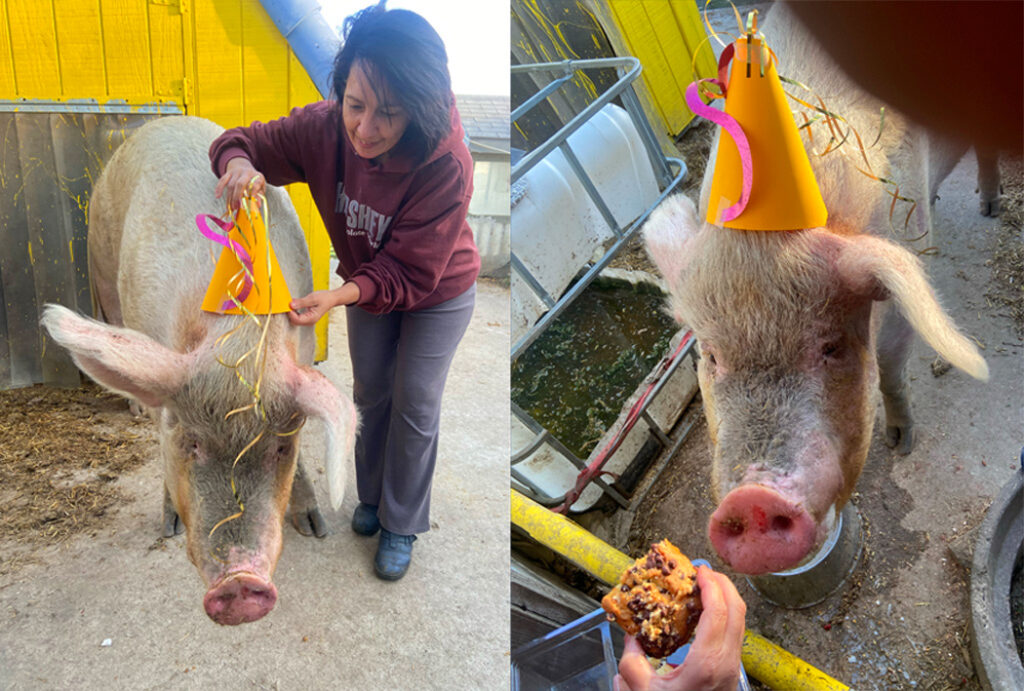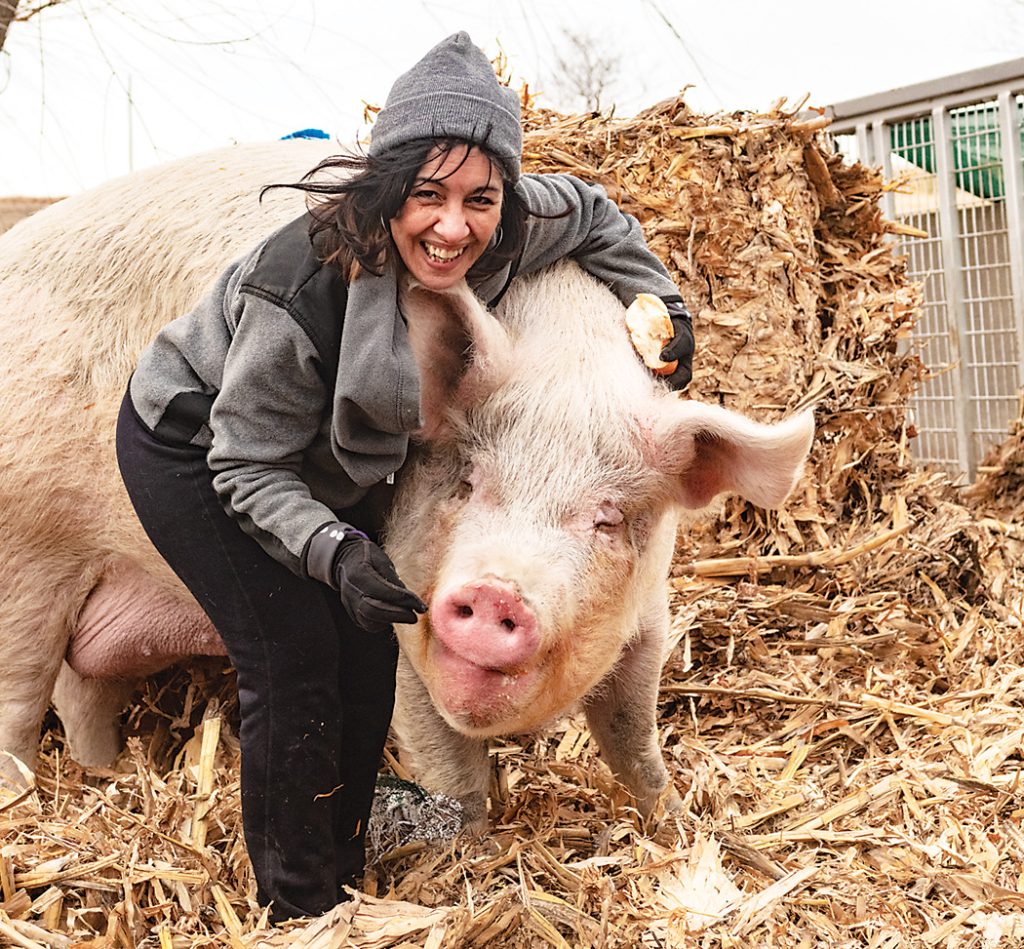
Lisa Santiago loves animals … and they know it. Furry and not so furry, wild and not so wild, creatures in need crawl out from burr-covered bushes to find this woman. Sometimes battered, often abandoned, they will occasionally even announce themselves by leaping into her arms.
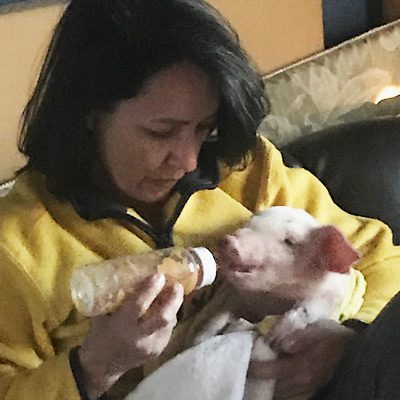
And Lisa says yes, I will help you. The skinny black kitty with lice and a chronic sinus infection that nobody wanted was soon named Nelson Mandela and incorporated into the household. The troubled German Shepherd that Lisa’s former tenant had forgotten to take with him when he left town was cared for the rest of her days. And when Lisa’s husband spotted an eight-pound piglet racing around the highway in a panic, Rob instinctively pulled over to rescue the little creature who’d likely just fallen off a truck at highway speed. Amazingly, several semi drivers stopped to help slow traffic until Rob could safely catch the animal. A few of them offered to take the pig home, but Rob had something else in mind—and it wasn’t meat. “No,” he told them, “I’m going to take it home to my wife—she loves saving things.” Bruised, bloodied, and limping, the piglet was brought to their country home outside of Mount Pleasant—and to Lisa. That first night they made a bed for the piglet in the basement, warmed by Rob’s Carhartt coat.
Life was tenuous for little Rudy, who for a time refused food and water. “What did I know about pigs? Absolutely nothing!” Lisa said. “I’m from Chicago—the closest I ever got to a pig was the Lincoln Park petting zoo!” But as with most things, Lisa was undeterred. Not afraid of research, nor too shy to ask for advice from her veterinary friend at the University of Illinois, Lisa was soon making progress with bottle-fed pureed food, and a few days later, tiny Rudy started eating by herself out of a bowl. Recovery was underway, and a great love story had begun.
Raising a Pig
Over the last few years, I’ve been fascinated by Lisa’s stories of “Rudy, the Piggy Princess” and have been a delighted recipient of the occasional photo, too—of Rudy in her “1920s bathing costume” (fashioned from a striped secondhand tank top as extra summer protection for Rudy’s sensitive skin), or most recently a picture of Rudy smiling, eyes closed, her blond lashes catching the soft light as she is treated by her favorite human to some hairbrushing—and mud—on an unseasonably warm winter day.
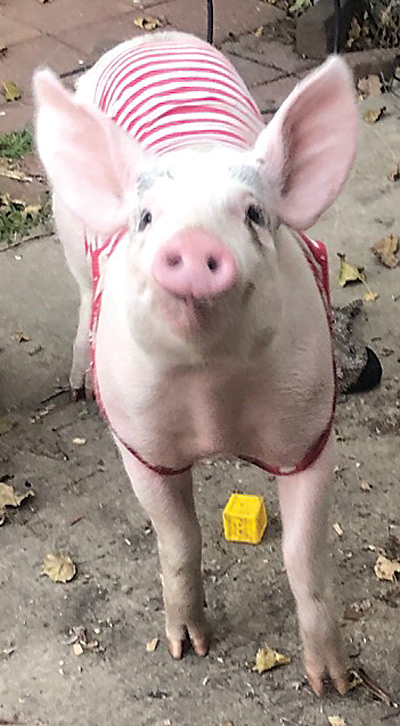
I get the happy highlights version, but for Lisa and Rob, it’s been a steep learning curve to care for this animal who now weighs (drumroll, please) … a whopping 900 pounds. The curve of Rudy’s back, when she’s standing on all fours, reaches Lisa’s armpit. Lisa is five feet tall.
Well-meaning farmers in the area warned Lisa not to keep her, she tells me. “They’d say things like, ‘Oh, you gotta get rid of her. She’s gonna grow up and eat you,’ or ‘They’re mean! She’s gonna be a giant. She’s gonna kill you.’ I started to get scared, of course, because I did realize, you know, that these guys have raised these animals for generations—and I’m a city girl. What do I know? But I knew that when I was with her she was very loving and sweet and she wanted attention, just like a dog or a cat, like this beautiful little creature who didn’t seem like she would ever hurt me intentionally. Any animal could hurt you by accident. But I still thought in the back of my mind, okay, if she does grow up to be a giant, she really should be well trained.”
For years, Lisa has taught “Intro to Psychology” and “Developmental Psychology” college classes, and instinctively applied her knowledge of “behavioral theory that a lot of people use when they’re training animals,” Lisa explains.
One of the first things she began teaching Rudy was to distinguish between fingers and food. “Early on, when I was feeding her or petting her, I would start by putting my finger in her mouth.” As Rudy grew larger, Lisa continued a regular routine of putting some—or all—of her hand in Rudy’s mouth, and Rudy would know to just spit it out. “To this day,” Lisa says, “I feed her by hand—which I’m sure people would think is insane, but I can feed her one little grape and she knows how not to bite me. She’s not snappy.
“I also wanted her to learn to not rush at the food,” Lisa explains, knowing there was a chance that down the line she’d have curious visitors from time to time. She wanted everyone to be safe. “So I would put my hand up, kind of like ‘stop.’ And I would tell her, ‘Back up! Go back!’” Rudy learned very quickly that giving Lisa space was part of the feeding routine. “In fact,” Lisa laughs, “the more she wants what’s in your hand, the further back she will go! It’s really cute. She loves mangos, just loooves mangos, and so if I show her a mango, she’ll start backing up . . . and backing up. It still amazes me to this day.
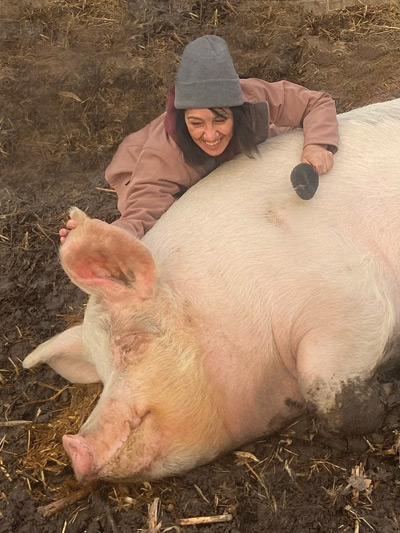
“Another thing was, when she was little, I made up this lullaby that I would sing to her as I rubbed her head, and again, trained her to sort of have a conditioned response to this song. Religiously—every night—I went out there, fed her, played with her, and then let her put her head in my lap, and I would just rub her head and sing her little lullaby and she would just calm down. So when it was time to have her spayed, in order for her to be calm at the vet’s office, I just laid her down, started petting her face, and sang her lullaby. To this day, when I sing to her, she’ll close her eyes, and I can put my head on her and feel her heart rate slow down. It’s almost meditative. All these behavioral techniques are the things that I just tried. And they all work. It still surprises me sometimes when I think about, wow, just how far we’ve come.”
Surprises & Misconceptions
I asked Lisa what else she’s learned from this experience—and about pigs in general.
“These two things were equally surprising to me. Number one is, everybody thinks that pigs are stinky. But Rudy? I sound insane, but I love her smell. I love it. It’s a different sort of ‘clean’ smell—I don’t even know what to compare it to. I love snuggling her, and I’ll take a big whiff right at the top of her head like between her ears—cuz there’s rarely any mud there,” she laughs.
“And the other misconception is, people say, ‘Oh, you know, he eats like a pig,’ meaning they’ll eat anything—and they’ll eat a ton of it. And I’ve learned that pigs won’t. Rudy and Leonardo and Kevin [Leo and Kevin are smaller pigs adopted to keep Rudy company] are very, very picky. For instance,” she says, “they will not eat green peppers! They will not. I’ll cut ’em up and I’ll even take a bite and say “Mmmm, yay, yummy, this is so good,” and I’ll give them a piece. They’ll take one bite and spit it out. And it will honestly lay there and rot. And they’re not fans of celery, either! But they looove iceberg lettuce.”
She frames it like this: “If you were locked up in a room, and all you were given was garbage to eat—then you’re gonna eat it. But if you have a choice between garbage and something delicious, you’re gonna choose the delicious thing!” Also contrary to popular belief, she says “they will not just eat and eat and eat and eat.” The average meal for Rudy is about 12 cups of food, “but if I offer her more than that, she will walk away. Rudy knows when she’s done.”
Beyond the Data
“One of the things we’re finding that’s hard is, because Rudy was not meant to live out her full lifespan,” Lisa tells me, “the data on how to keep her healthy, or what she’s going to encounter as she ages, is really hard to find.”
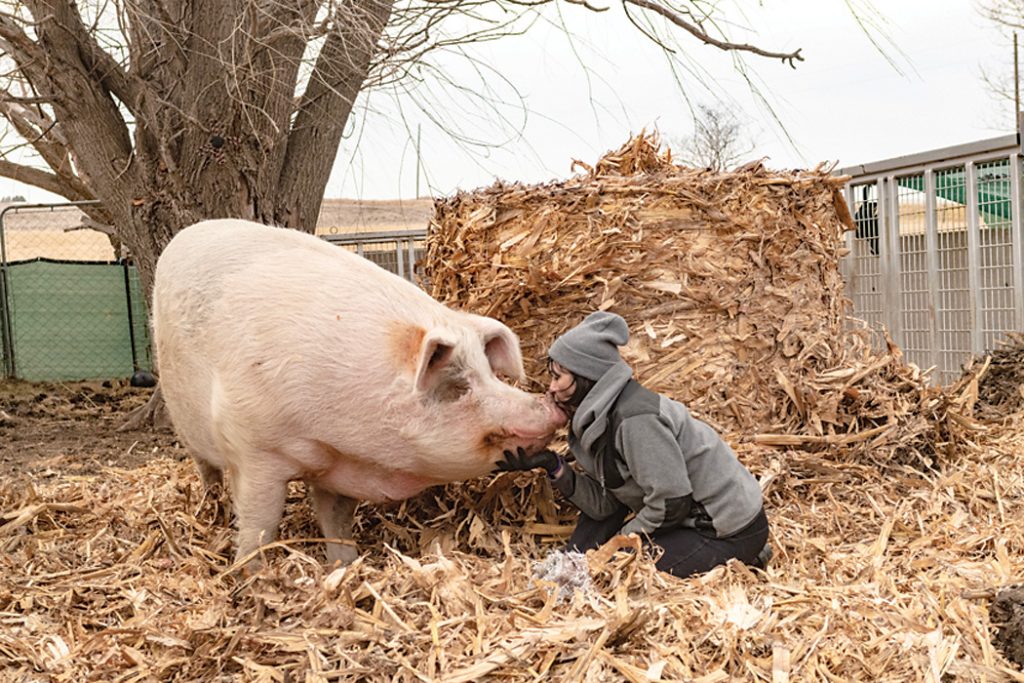
Rudy’s four years old now—which is practically unheard of for pigs of her kind—bred to grow fast and bred not to last longer than about six months. Rudy’s continually outliving the data, and continually outgrowing her home.
Rudy is about to get her fourth home, an 8-by-12-foot house that will be facing, as always, Lisa and Rob’s southern sliding glass door. “She likes to see us, and she likes to see who’s coming and going—it makes her feel comfortable.”
Despite a weak hind leg that Lisa still keeps an eye on, Princess Rudy is one healthy, happy girl—for most of the year. But after a few scary close calls in the heights of summer and winter, Rob and Lisa aren’t messing around. Rudy’s new “condo” is coming with built-in heat and an air conditioner.
An air conditioner? For a pig?? you ask? Since slaughter is not the end game for Rudy, but a full and happy life is, here’s why this decision feels like the right one for Lisa and Rob.
For Rudy’s first three summers, shade, shelter, and mud had done the trick to keep her pretty comfortable. But during a particularly scorching week last July, Rudy stopped eating and drinking. It wasn’t until Rudy began to seizure that Lisa realized what was happening. Heat stroke. Lisa ran outside with cool towels and sprayed Rudy down with water. “It was terrifying. I cry when I think about it. . . . And then to get her hydrated, oh my God, we tried so many things.” Rudy just wouldn’t drink. “Finally, what I learned to do that worked the best is get loaves of French bread, or a baguette, rip off some pieces and soak them in this farm-store brand of Pedialyte that was recommended, and feed them to her by hand. That’s how we get her hydrated in times when it’s too hot—or too cold.”
As Rudy ages, she requires increasingly vigilant care, and here’s part of the reason why: pigs are naturally sensitive to heat stress to begin with. For one thing, they have very few sweat glands—the cooling mechanism that most other mammals benefit from. And with small lungs and thick subcutaneous fat, the heat has nowhere to go—part of the reason why a mud bath, for pigs, offers such necessary therapy. Lisa laughs about it, but she takes Rudy’s mud very seriously. “I work to keep it a really good consistency. She gets the best spa. This is quality mud.”
Since Rudy’s breed has been modified to grow bigger faster—and since size correlates with body temperature, heat stroke is a real danger for a maturing pig, according to a 2003 study by Tami Brown-Brandl. “New genetic lines produce 20 percent more heat than their counterparts in the early 1980s.” And in the 20 years since that study was done, it’s estimated that the body temperature of a mature factory farm pig has gotten even more extreme. “The temperature thing is one of the most difficult things we’ve had to work on,” says Lisa.
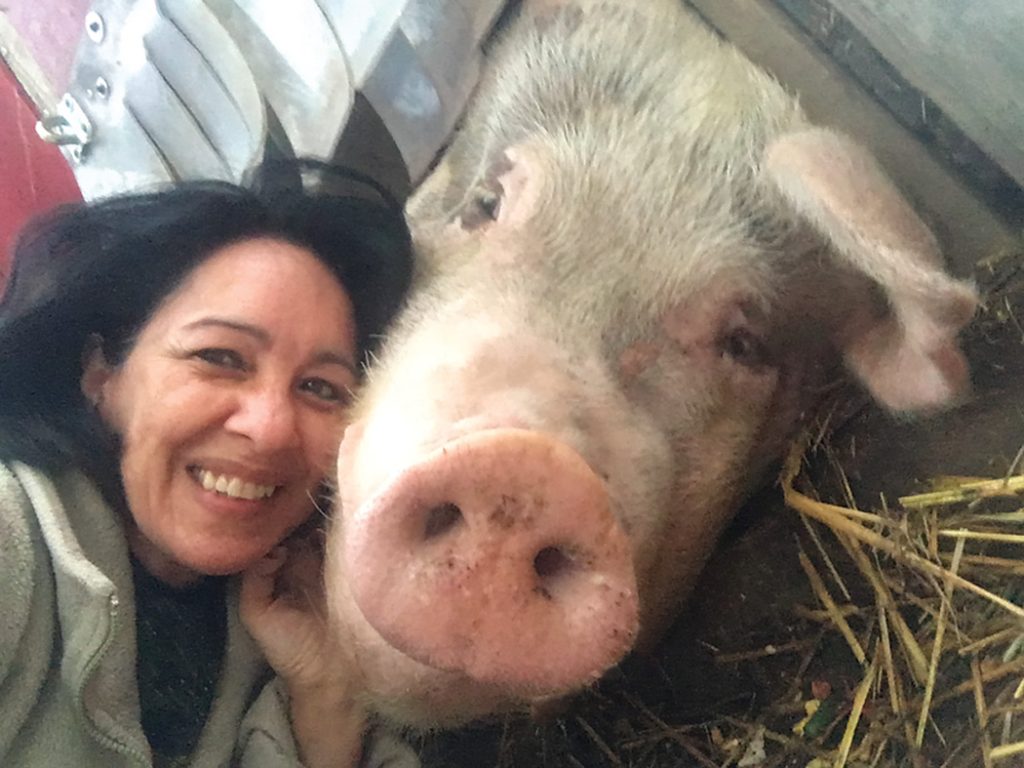
Lisa is beyond grateful that she and her husband have the space and the means to care for Rudy and her two “little brothers.” The two smaller pigs ended up bonding more with each other than with Rudy, but Lisa feels it’s been important to have companions around “that speak Rudy’s language.” Rudy’s best buddies, other than Lisa and Rob, are currently the farm cats, particularly a black one they call Little Mama who sleeps with Rudy every night in her house.
A Good Life
“It’s changed me,” Lisa says. “In so many ways. Not just with pigs, but with other intelligent beings that have emotional responses that really you can see. But I don’t run around on my soapbox trying to change people,” Lisa adds. “I don’t talk about it. I don’t want to be that woman—‘Oh, there’s that lady with the pigs who’s gonna to try and get you to stop eating bacon.’ I don’t wanna lose friends over this—or family! I mean, my God, my stepmother used to get us up on the weekends by cooking a pound of bacon, and we were like, ‘Ooooohhhh, bacooonnnn.’ My sister and I would get outta bed like zombies heading towards the bacon. And when we got Rudy, there was carnitas in my freezer.
“Now that I know how emotional and wonderful and intelligent they are—and the studies I’ve read about the intelligence of these animals—now that I know? I can’t. I just can’t. And people are very respectful about it. I don’t try and change them and they don’t try to change me. But I do think it would be nice if more people did try to understand.
“When Rob was young, growing up here in Iowa, he worked on these farms and he would castrate or neuter these pigs without any anesthetic or whatever—it’s just what they’d do. And so it really surprised me that he went out of his way to save this one little pig on the highway. But he did it. And now he loves her, too. I mean, he’s the one who buys her all these bigger houses,” she chuckles.
“What is it that Temple Grandin says? ‘Life is cruel, but we don’t have to be.’ I just think if we’re going to use these animals for our sustenance, the very least we can do is give them dignity.” Temple Grandin is a widely respected animal behaviorist, a prominent proponent for the humane treatment of livestock, and the author of more than 60 scientific papers on animal behavior. “We need a Temple Grandin of pigs, for sure.”
“Hey, guess what,” I say, only half kidding, “You’re it!”
Lisa says, “Oh, somewhere down the line, there is a farm sanctuary in my future, I can feel it. All these people who have their sanctuaries already, hats off to them. Someday I’ll be joining the group. I have to save up money to be able to do that, so that’s where we are.
“I think part of it is that we never had human children,” Lisa tells me. “And so all of that unconditional love has to go somewhere. But, honestly, if we had kids? They’d be out there with us, helping with the animals.”
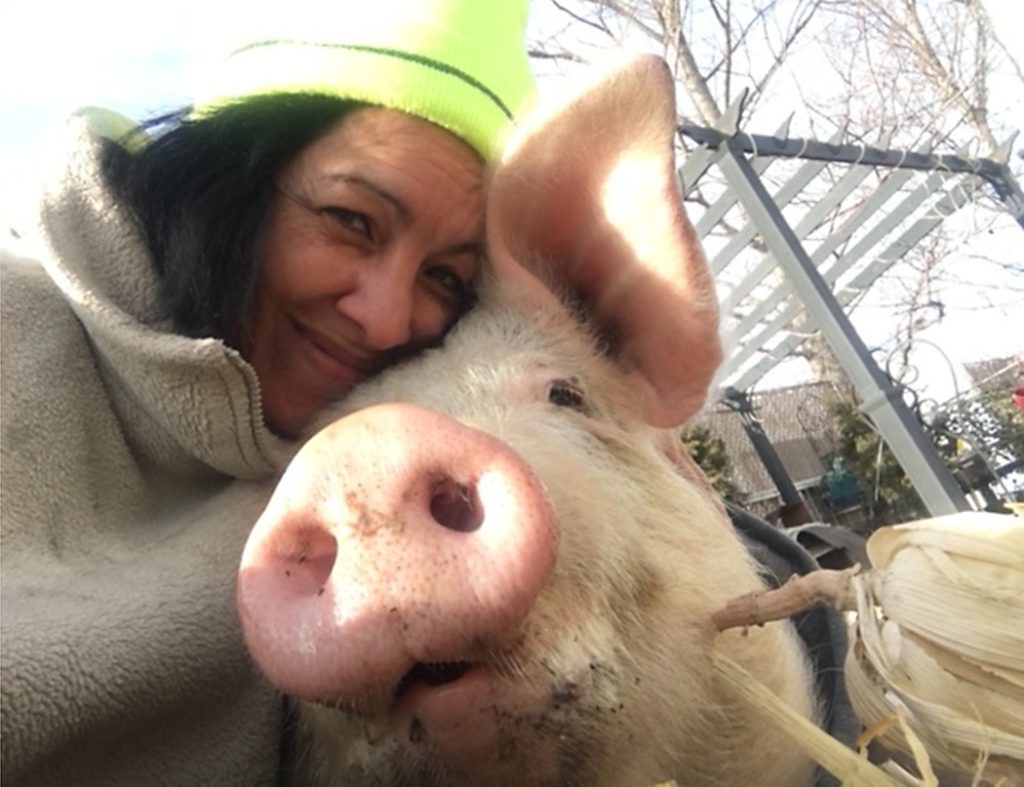
Spring and autumn have new meaning at Rob and Lisa’s. These are times of the year when Rudy loves to be out of her house enjoying, well, pretty much everything. “The best moments are coming home from work and Rudy’s out back sitting in the shade of the tree. It’s a beautiful day. And you go out there with a mango.
“Life is good. Life is good. Life is good.”
